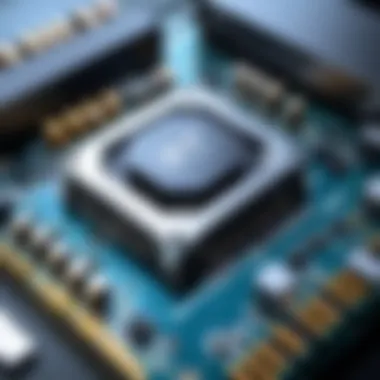Unveiling the Complexities of CPU Components: A Detailed Exploration


Overview of CPU Components
In this section, we will embark on a detailed exploration of the intricate components that form the central processing unit (\
Introduction to CPU Components
In this section, we will delve into the fundamental elements that comprise a CPU, also known as the central processing unit. These components are the building blocks of computing power, orchestrating complex operations to enable the seamless functioning of electronic devices. Understanding the intricacies of CPU components is pivotal for individuals interested in delving deeper into the realm of computer architecture and technology.
Arithmetic Logic Unit (ALU)
Overview of ALU Functionality
The Arithmetic Logic Unit (ALU) serves as the beating heart of the CPU, responsible for executing arithmetic and logical operations with precision and speed. Its primary function revolves around performing calculations and making decisions based on input data, crucial for the overall processing efficiency of the CPU. The ALU's streamlined design and efficient operation make it a cornerstone of CPU functionality, showcasing its prowess in handling complex computations.


Importance of ALU in CPU Operations
The ALU's significance in CPU operations cannot be understated, as it essentially drives the core processing capabilities of the entire system. Its swift execution of mathematical operations and logical comparisons directly impacts the speed and accuracy of data processing, thereby enhancing overall computing performance. Incorporating a high-performing ALU design is essential for optimizing CPU functionality and maximizing operational efficiency.
ALU Design and Implementation
When it comes to the design and implementation of the ALU, meticulous attention is paid to achieving a balance between performance and energy efficiency. Engineers strive to develop ALU architectures that deliver exceptional speed and computational power while minimizing energy consumption. The intricate design considerations behind ALU development aim to harness its full potential in enhancing the computational prowess of modern CPUs, underlining the critical role it plays in driving technological advancements.
Control Unit (CU)
Role of Control Unit in CPU
The Control Unit (CU) acts as the brain of the CPU, overseeing and directing the execution of instructions and tasks within the system. Its primary responsibility lies in deciphering and orchestrating the sequential flow of operations, ensuring that each task is carried out accurately and efficiently. By maintaining control over the CPU's functions, the CU upholds the integrity of program execution and data handling processes.
Instruction Execution Process


Within the CPU framework, the Instruction Execution Process managed by the CU entails decoding, fetching, executing, and storing instructions in a methodical manner. This intricate process dictates the smooth flow of operations within the CPU, optimizing task completion speed and resource utilization. The collaborative efforts between the CU and other CPU components facilitate a streamlined execution process that aligns with the system's operational objectives.
Coordination with ALU
The seamless coordination between the Control Unit and the Arithmetic Logic Unit (ALU) is paramount for achieving harmonious CPU functionality. The CU instructs the ALU regarding the specific operations to be performed, ensuring synchronization and coherence in computational tasks. This collaborative synergy between the CU and ALU underpins the efficient processing capabilities of the CPU, culminating in heightened performance and operational fluidity.
Conclusion
In wrapping up the exploration of CPU components, it is evident that each element, from the Arithmetic Logic Unit to the Control Unit, plays a pivotal role in the seamless functioning of a central processing unit. Understanding these components is essential for individuals delving into computer architecture and technology, as it forms the foundation of computational processes and system operations. By comprehending the intricate details of the CPU components, one can gain a deeper insight into the inner workings of computers, paving the way for efficient troubleshooting, system optimization, and design improvements.
Summary of CPU Components
Integration of CPU Elements
The integration of CPU elements is a critical aspect of central processing unit functionality. By amalgamating the Arithmetic Logic Unit, Control Unit, Registers, Cache Memory, Clock Generator, Data Bus, Address Bus, Control Bus, Heat Sink, and Cooling System, a cohesive computational powerhouse is created. This seamless blend of components ensures smooth communication, data processing, and system operation, ultimately enhancing the overall performance and efficiency of the CPU. The integration of CPU elements is a widely adopted strategy in modern computer architectures due to its ability to streamline operations, reduce latency, and optimize resource utilization.


Impact on Processing Speed
The impact on processing speed is a paramount consideration in CPU design and performance evaluation. The efficiency of data processing, instructions execution, and system response time are directly influenced by the processing speed of the CPU. A higher processing speed translates to faster computation, seamless multitasking, and enhanced user experience. However, the quest for exponential processing speed improvements must be balanced with considerations of power consumption, heat generation, and thermal management to maintain system stability and reliability.
Future Developments in CPU Design
Future developments in CPU design hold the promise of revolutionary advancements in computational capabilities and efficiency. With the integration of novel materials, architectures, and technologies, the future CPU designs are poised to deliver unprecedented performance, energy efficiency, and versatility. Innovations such as neuromorphic computing, quantum computing, and photonics-based processors are reshaping the landscape of CPU design, offering exciting possibilities for enhancing processing power, data handling, and scalability in diverse computing applications.
Final Thoughts
Continuous Evolution of CPU Technology
The continuous evolution of CPU technology underscores the relentless pursuit of innovation and enhancement in the computing industry. Through ongoing research, development, and collaboration, CPU technology continues to push the boundaries of performance, efficiency, and versatility. The evolution of CPU technology not only drives technological progress but also catalyzes breakthroughs in artificial intelligence, big data analytics, and scientific computing, shaping the future of digital transformation and computational capabilities.
Implications for Computing Industry
The implications of CPU advancements resonate across the computing industry, influencing hardware design, software development, and technological adoption. A paradigm shift in CPU capabilities can catalyze disruptive changes in computing paradigms, business models, and user experiences. As CPU technology continues to advance, it propels industry innovation, economic growth, and societal transformation, heralding a new era of computational possibilities and digital connectivity.
Recommendations for Further Reading
For readers seeking deeper insights into CPU components, architecture, and technology, exploring scholarly resources, research papers, and specialized literature is highly recommended. In-depth readings on microprocessor design, CPU optimization techniques, and emerging trends in computer architecture can provide valuable perspectives on the past, present, and future of CPU technology. Engaging with authoritative textbooks, academic publications, and industry reports can broaden one's understanding of CPU components, design principles, and challenges in contemporary computing environments.







